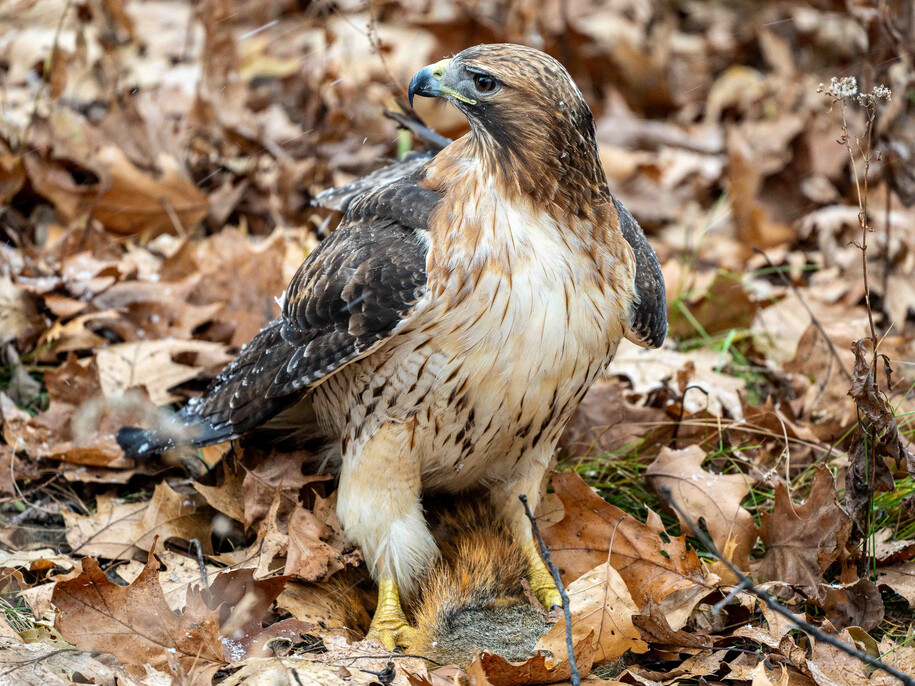It’s a bird, it’s a plane, it’s — well, in our case, it’s actually probably a bird. It could even be a raptor.
If you spend enough time looking up, you’re likely to spy some of Iowa’s frequent flyers. The state has several species of hawks, eagles and vultures that call Iowa home or visit during the year. We’ve put together a non-comprehensive list.
Here’s how to tell them apart.
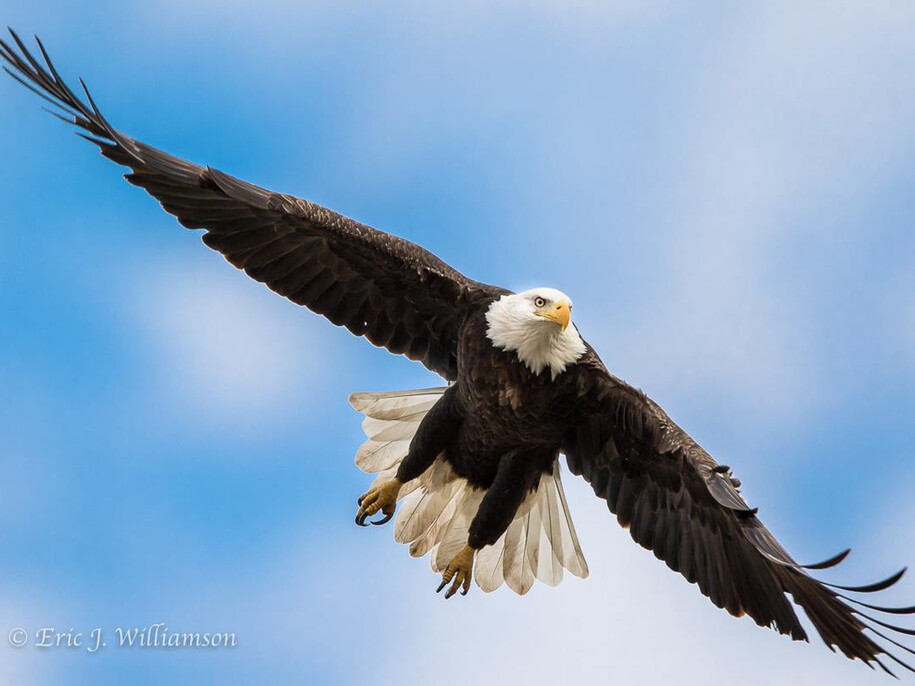
Bald Eagle – Haliaeetus leucocephalus
Very large raptor with broad wings and tail and large yellow beak and talons.
Adults have dark brown bodies and wings, contrasting with white heads and tails.
Immature birds have brown heads and mottled white and brown bodies, wings and tails, with white heads and tails appearing at 5 years of age.
First-year birds are mostly brown and have dark gray beaks that turn yellow by year three.
Immature bald eagles are sometimes confused for golden eagles, but note that golden eagles only have white in limited areas as juveniles (large patches under the wings, and a broad band on the upper tail) but are otherwise brown, with their bodies never appearing mottled like juvenile bald eagles.
Bald eagles are often found in forested areas near water and primarily eat fish and waterfowl, but they also take advantage of carrion and are often found feasting on carcasses of roadkill.
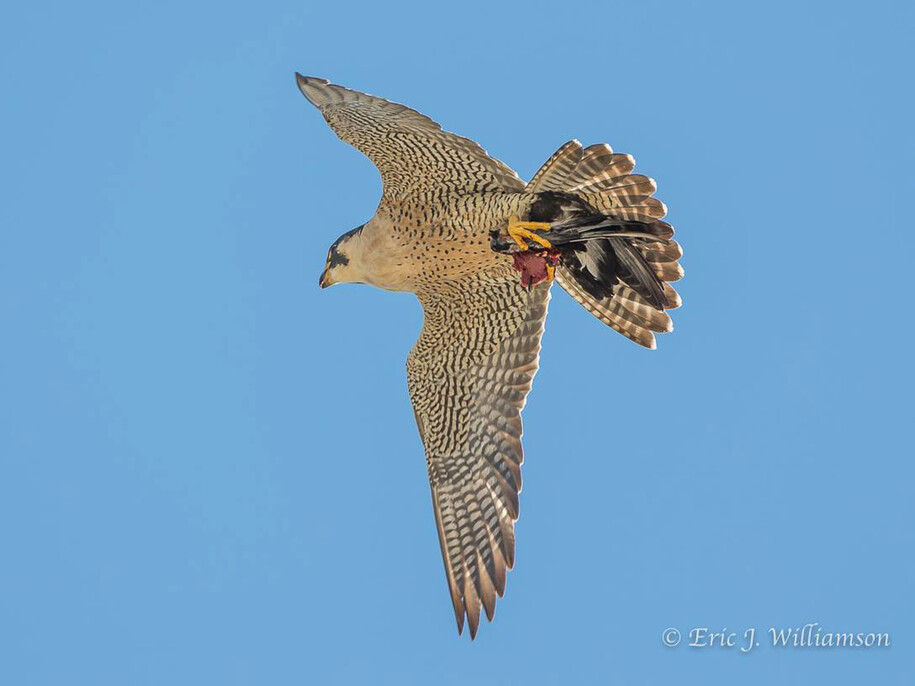
Peregrine Falcon – Falco peregrinus
- Large falcon with large body, long pointed wings and a fairly long tail.
- Adults have dark gray/black back and wings and head with large distinctive “sideburn” on a white face and neck; their chest and underwings have a dark-and-light checkered pattern.
- Juvenile birds appear similar to adults but have tan/buffy colored breasts with dark vertical barring.
- Peregrine falcons primarily prey on birds, and capture them while in flight.
- Peregrines in Iowa nest on natural rock ledges on the bluffs along the Mississippi River, or utilize nest box structures placed on large buildings and bridges in urban areas.
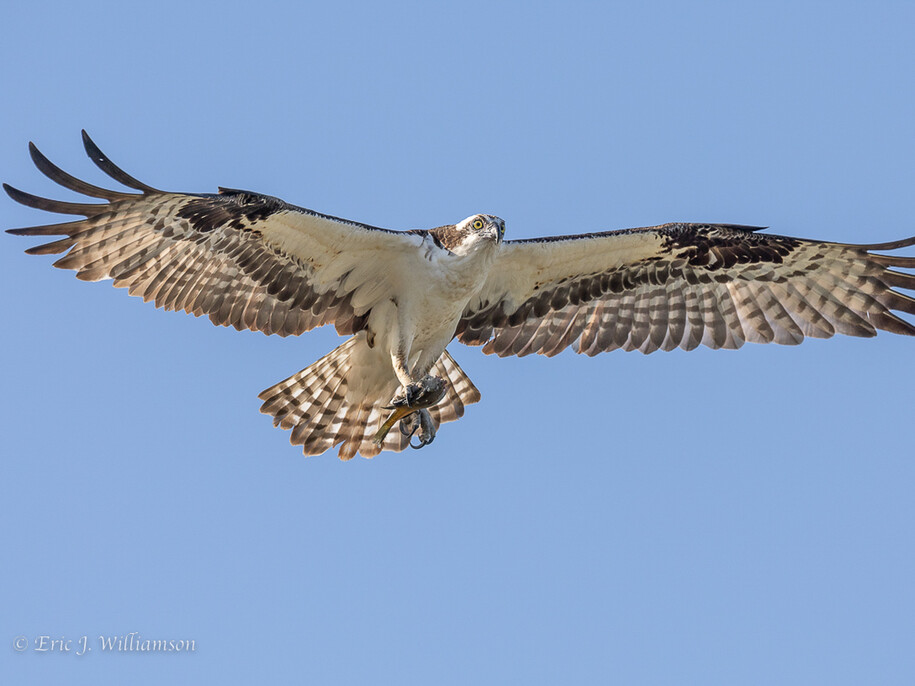
Osprey – Pandion haliaetus
- Large raptor with long, pointed wings.
- Ospreys have dark wings and backs contrasting with white underparts.
- Dark stripe on face running from the eye to the back of the neck.
- In flight, the wings are slightly bowed, creating an M-shape silhouette from below.
- In flight from below, their white belly contrasts with dark spots on wrists and barred flight feathers.
- Exclusively eat fish and are often seen near bodies of water.
- Ospreys breed in Iowa, but migrate south during the winter.
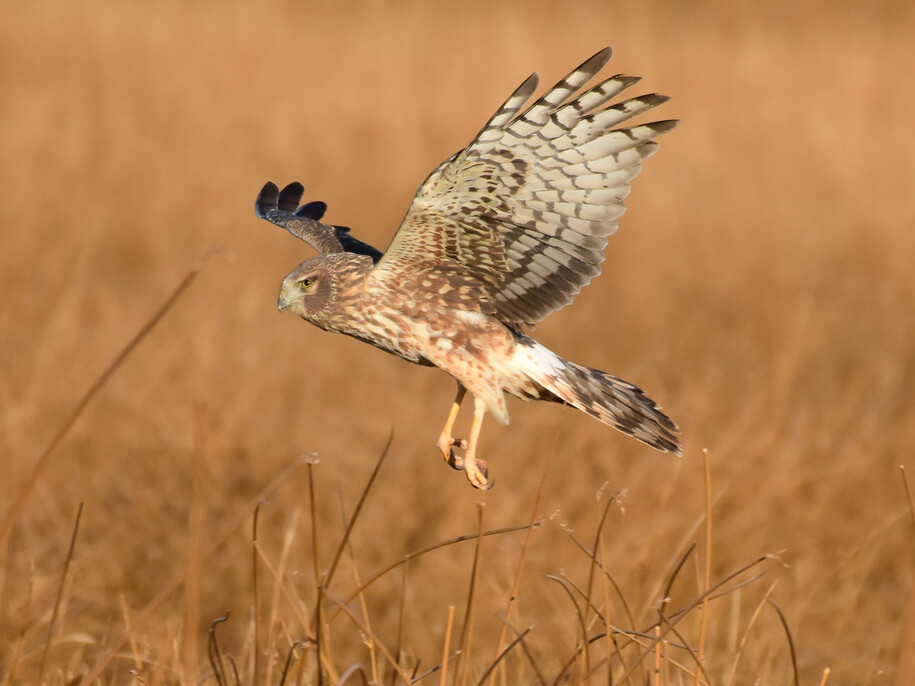
Northern Harrier – Circus hudsonius
- Medium-sized raptor with long, broad wings and a long tail.
- In flight, they show a distinct white patch on their rump at the base of the tail.
- Adult males are gray above with dark trailing edges of the wings.
- Females are pale below with brown streaking.
- Immature birds have a tan colored underside lacking streaks and a more brown-colored head.
- Harriers have an owl-like face with distinctive facial disks.
- Harriers are often seen gliding low over grasslands and wetlands to hunt for prey, making quick agile turns in flight.
- Northern harriers breed in Iowa, but count yourself lucky if you see one — they are listed as an endangered species in Iowa. They’re most often seen during fall migration or winter.
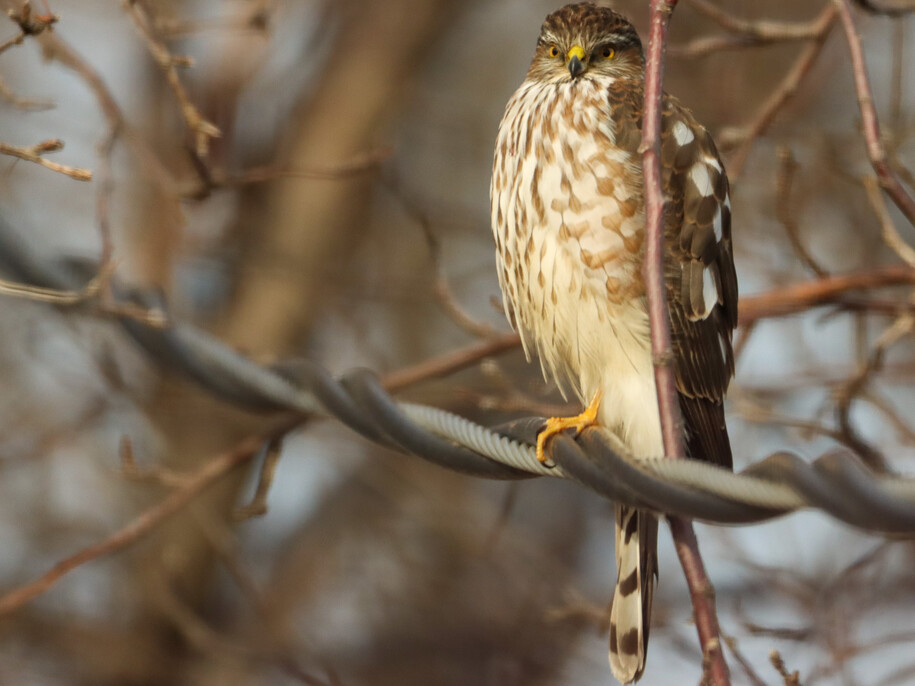
Sharp-shinned Hawk – Accipiter striatus
- Small raptor with short broad wings, long narrow tail, and a small head with relatively large-looking eyes.
- Barred tail with horizontal stripes alternating between dark and light, visible on the top and underside of the tail.
- Adults have a dark blue-gray back, with narrow horizontal orange bars on the breast.
- Immature birds are brown with thick brown streaks on the breast.
- Flap-flap-glide flight pattern, with wings pushed forward slightly farther than head.
- Eats small songbirds and is found in forests, including wooded neighborhoods.
- Difficult to distinguish from cooper’s hawk: note the smaller head, thinner legs and feet, and square tail compared to cooper’s hawk.
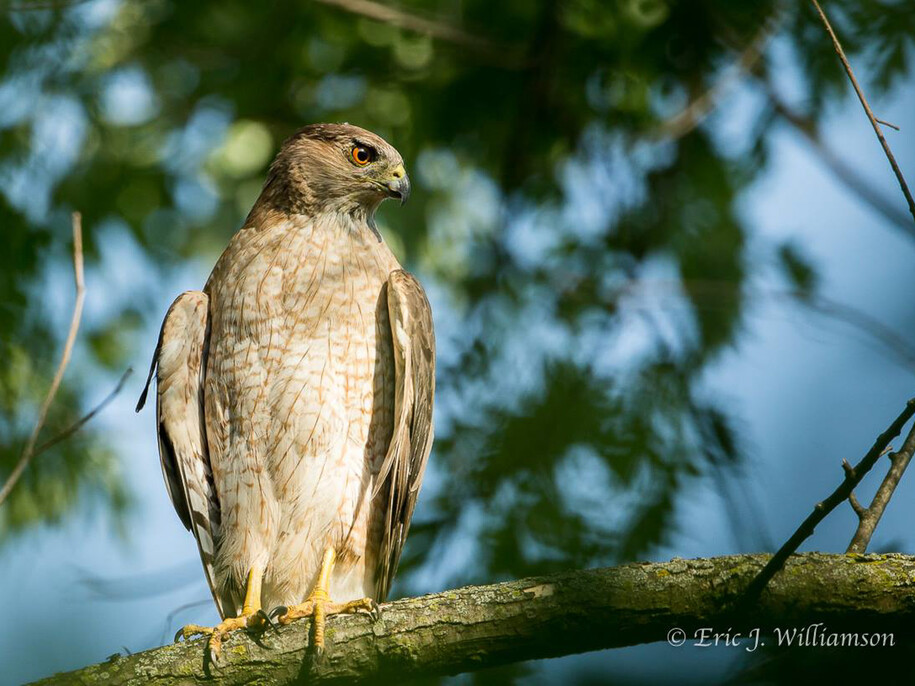
Cooper’s Hawk – Accipiter cooperii
- Small to medium-sized raptor with short, broad wings and long, narrow tail.
- Barred tail with horizontal stripes alternating between dark and light, visible on the top and underside of the tail.
- Adults have a dark blue-gray back with a contrasting black cap and red eye, with pale dense orange barring on the breast.
- Immature birds are brown with thick brown streaks on the breast and a yellow eye.
- Flap-flap-glide flight pattern, with the head sticking out past the wings.
- Eats small songbirds and is found in forests, including wooded neighborhoods.
- Difficult to distinguish from sharp-shinned hawk: note the larger head with darker contrasting cap, thicker legs and feet, and rounded tail with broader white terminal band compared to Sharp-shinned Hawk.
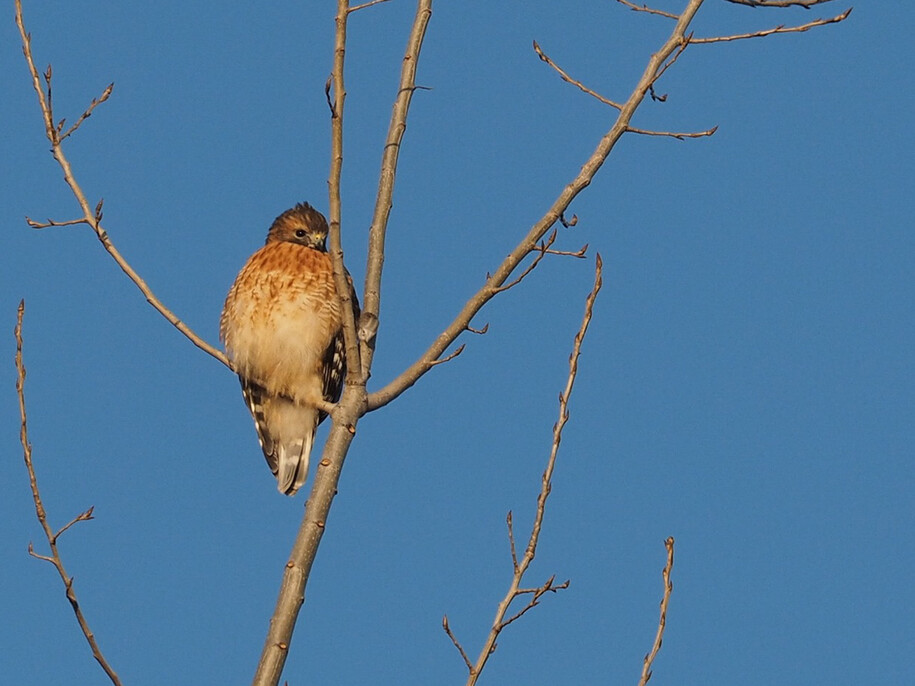
Red-shouldered Hawk – Buteo lineatus
(a less common species)
- Medium-sized hawk with slim body, broad wings, and fairly long tail.
- In flight, wings appear squared off and have a translucent crescent near the wing tips.
- Adults have a rich reddish-brown chest, and black-and-white checkered wings and black and white striped tail.
- In flight, adults display reddish armpits and breast with light- and dark-banded underwings and tail.
- Immature birds have brown wings with variable dark streaks on a light breast with narrow bands of brown on a white tail and underwings (visible in flight).
- Found in bottomland forests along rivers and eat small mammals, snakes and amphibians.
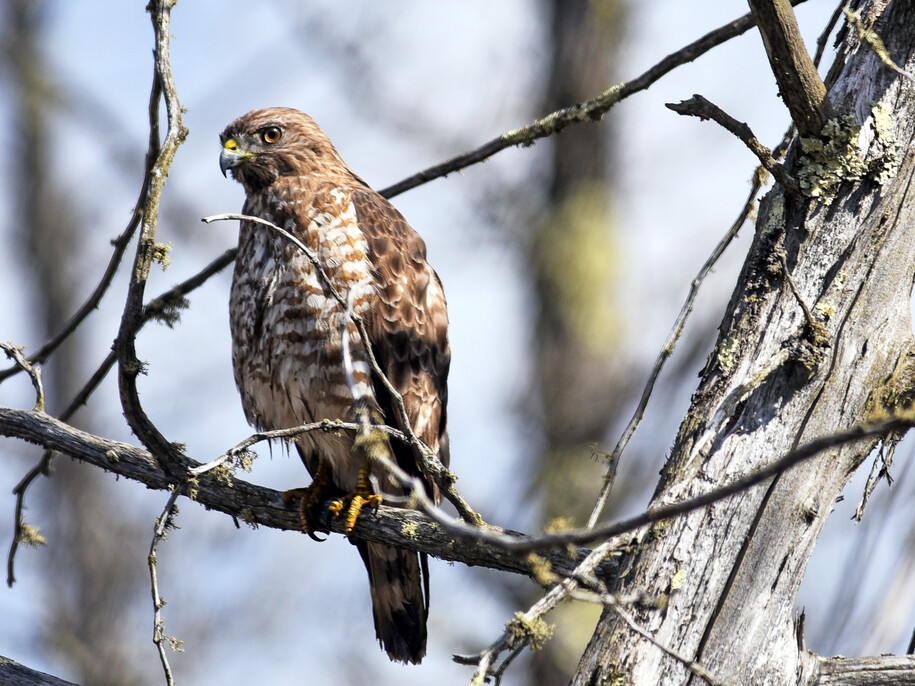
Broad-winged Hawk – Buteo platypterus
(a less common species)
- Small raptor with broad wings and short tail.
- Adults have brown wings and heads with horizontal barring on the light breast and large black and white bands on the tail.
- In flight, adults have light under parts with a distinct dark border on the trailing edge of the wings and district black and white stripes on their tail.
- Juveniles are brown overall with variable amounts of brown barring on their light breasts, with many narrow bands of gray on their tails.
- Broad-winged hawks are found in large forests and eat small mammals, insects and amphibians.
- Broad-winged hawks breed in Iowa and migrate south during the winter.
Red-tailed hawk – Buteo jamaicensis
- Large raptor with broad wings and tail, light body and underwings and brown wings and head.
- Adults have a distinctive red tail, and light breast with a variable dark belly band.
- In flight, adults have light underwings with darker wing tips and edges of flight feathers.
- Immature birds appear similar to adults but with more streaking on breast, barring under wings, and a brown barred tail.
- There are many color morphs of red-tailed hawks, ranging from completely dark brown, to almost completely white.
- Often found perched in trees, on signs, or on power lines and poles along roadsides scanning for prey.
- The most common hawk species in Iowa.
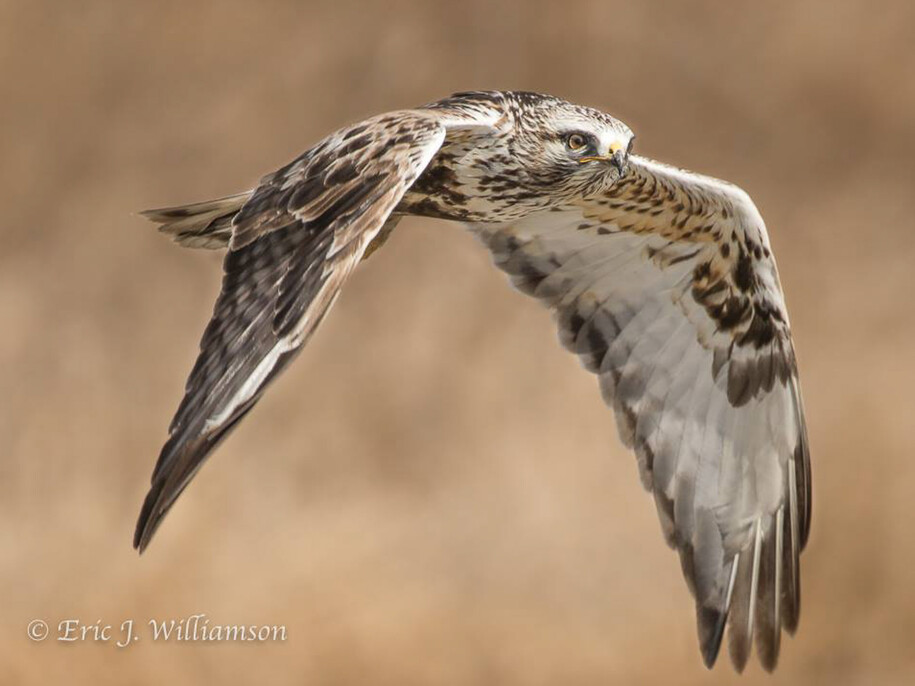
Rough-legged Hawk - Buteo lagopus
(winter and migration)
- Large bodied raptor with fairly narrow and long wings and a long tail.
- Unlike many other hawks, their legs are feathered all the way to the feet.
- Adults have variable brown streaking with a darker band of feathers on their belly, in flight they have distinctively dark patches at the bend (wrist) of their underwing, with the tail white at the base and black at the tip.
- Juveniles often have a much darker contrasting belly band and lighter underwings with very distinct dark wrist patches under the wings.
- Seen during winter in Iowa, and found in grassland, wetland and agricultural areas with patchy trees.
- Hunts either while perched or on the wing.
- Breeds in the arctic.
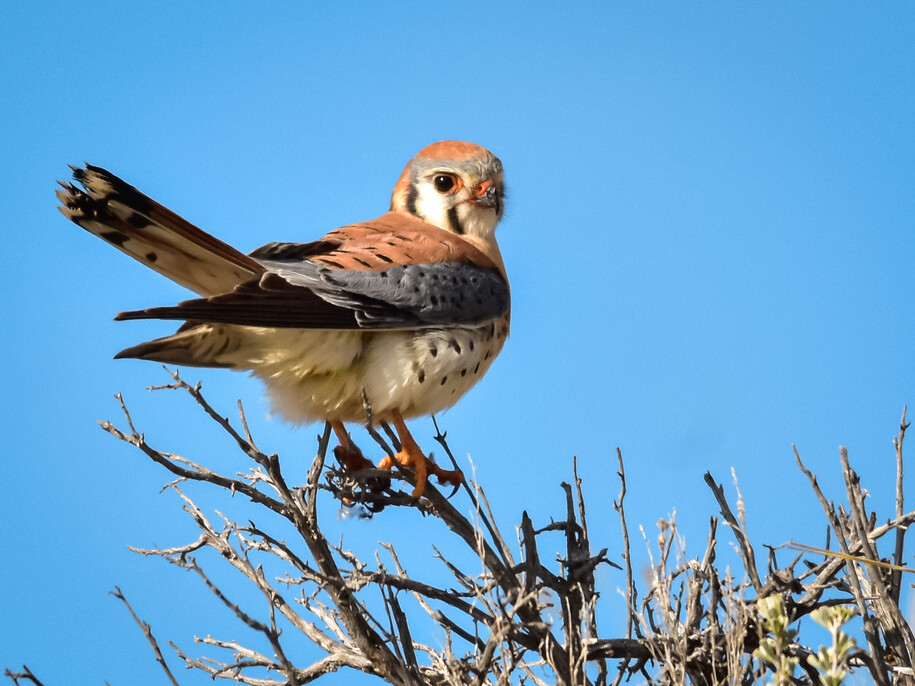
American Kestrel – Falco sparverius
- Small falcon (about the size of a mourning dove) with a small head and beak, pointed wings and narrow tail.
- Adult males have a tan body with a rusty orange back and slate-blue wings and head and two vertical black patches on the face (a mustache and sideburn).
- Adult females are similar in pattern, but overall more dull in color, with dark barring on the wings and back.
- Juvenile birds look similar to females but have vertical streaking on the breast, they molt into adult plumage during their first fall.
- In flight, identified by long pointed wings, barring under wings, pale breast and deep wing beats.
- American kestrels hunt while flying, often hovering in place, and when perched are often seen bobbing their tail.
- Kestrels hunt for small rodents and insects in open habitats, but nest in cavities (like hollow trees or nest boxes), and are often seen perched on power lines.
Turkey vulture – Cathartes aura
- Large-sized raptor with black body with dark gray flight feathers and tail.
- Adults have a red featherless head, immature birds have an ashy-gray head.
- Often soar with wings held upward in a slight v-shape (or dihedral) and appear to teeter in flight.
- Specialize in eating carrion (carcasses of dead animals).
- Can be seen as a sign of spring when they return, as they migrate south during the winter.
For more, check out our Iowa Wildlife and In Your Own Backyard boards on Pinterest or follow us on Instagram.
